What Makes The Guide Special
When we first wrote The St. Martin’s Guide to Writing, our goal was to provide students with the clear guidance and practical strategies they needed to harness their potential as writers—an achievement that will be key to their success in college, at work, and in the wider world. We also wanted to provide instructors with the hands-on tools they needed to help their students write with a clear understanding of their rhetorical situation. Our goals have remained the same, and so The St. Martin’s Guide retains the core features that over the years have drawn so many instructors and programs to the Guide. But now it also includes many new features that we believe will keep the Guide the most practical hands-on text for teachers and students.
Core Features of the Guide
The St. Martin’s Guide retains its emphasis on active learning—learning by doing—by providing practical guides to writing, promoting genre awareness to aid the transfer of writing skills from one genre or context to another, and integrating reading and writing through hands-on activities of critical thinking, reading, and analysis.
Practical Guides to Writing
Each chapter in Part One offers practical, flexible guides that help students draft and revise essays in a variety of analytical and argumentative genres. Commonsensical and easy to follow, these writing guides teach students to
- assess the rhetorical situation, focusing on their purpose and audience, with special attention to the genre and medium in which they are writing;
- ask probing analytical questions;
- practice finding answers through various kinds of research, including memory search, field research, and traditional source-based research.
These flexible guides to writing begin with a Starting Points chart to offer students multiple ways of finding the help they need when they need it. Each also includes a Critical Reading Guide to help students assess their own writing and the writing of their classmates and a Troubleshooting Guide to help students find ways to improve their drafts. All these guides are organized and color-coded to emphasize the genre’s basic features. In short, the guides to writing help students make their writing thoughtful, clear, organized, and compelling—in a word, effective for the rhetorical situation.
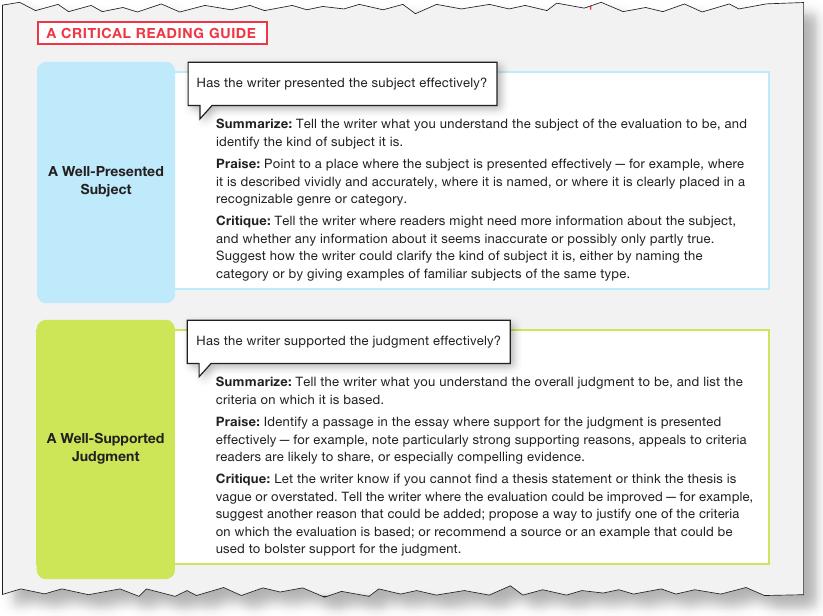
Genre Awareness
Each chapter in Part One introduces a genre of writing. By working through several genres, students learn how writers employ the basic features and strategies of a genre to achieve their purpose with their readers. The Arguing a Position essay, for example, teaches students to examine critically their views on a controversial issue, as well as those of their prospective readers, with an eye toward developing an argument that not only is well reasoned and well supported but also responds constructively to readers’ likely questions and concerns. The Finding Common Ground essay teaches students how to analyze opposing arguments on a controversial issue—unpacking the ways writers use the classical appeals of logos, ethos, and pathos to promote their underlying values and beliefs. Whereas the primary purpose in Arguing a Position is persuasive, to convince readers to take seriously the writer’s point of view, the primary purpose in a Finding Common Ground essay is analytical, to explain the basis for divergent points of view and determine where, if anywhere, compromise might be forged. Studying multiple genres—as well as multiple examples of each genre—helps students understand that genre is not simply a way for rhetoricians to classify texts or for teachers to construct assignments. More important, genre awareness helps them understand how we actually communicate with one another in a variety of contexts and situations. Genre awareness makes us better communicators, better readers and writers, in whatever medium we are using.
Systematic Integration of Critical Reading and Reflective Writing
Students are asked to read and analyze essays in the genre they are learning to write. The activities following the professional reading selections prompt students to read actively by asking them to reflect on the essay and connect it to their own experience, and to read like a writer, paying attention to the strategies the writer uses to convey his or her ideas and connect with readers.
What’s New
Although the tenth edition of The St. Martin’s Guide to Writing builds on the success of previous editions, many of the strategies the Guide employs have changed in order to connect more effectively with a new generation of teachers and students. Even in the years since the publication of the ninth edition, there have been the increasingly burdensome demands on the time, attention, and energy of teachers and students and the tremendous growth in access to high-speed Internet. So the guiding principle for the tenth edition has been to maximize active learning by enhancing the book’s visual rhetoric, giving students more opportunities for hands-on learning, and providing students and instructors with more readings and more interactive activities than ever before: more showing, more doing, more options, more learning.
 More Readings in the e-Pages
More Readings in the e-Pages
The Guide is the first rhetoric to integrate e-Pages that come alive online with video, Web sites, podcasts, and more. An electronic extension of the printed page, e-Pages make it possible for us to include more reading selections in the Guide than ever before. The e-Pages for The St. Martin’s Guide, Tenth Edition, include the following:
- Ten more student essays. Each is accompanied by a headnote identifying the student writer and describing the assignment that the essay was written to fulfill, are available free through the e-Pages. (Additional student essays are also available on the book’s companion site and in Sticks and Stones, a collection of student essays from across the country that is available free to adopters.)
- Twenty-one more professional readings take advantage of what the Web can do to give instructors more choices than ever before. Each reading is accompanied by a headnote describing the writer and the venue in which the selection originally appeared, and each is followed by an Analyze & Write activity that asks students to think and write about how the selection employs a basic feature of the genre. A Consider Possible Topics feature is also included to help students identify topics about which they could write.
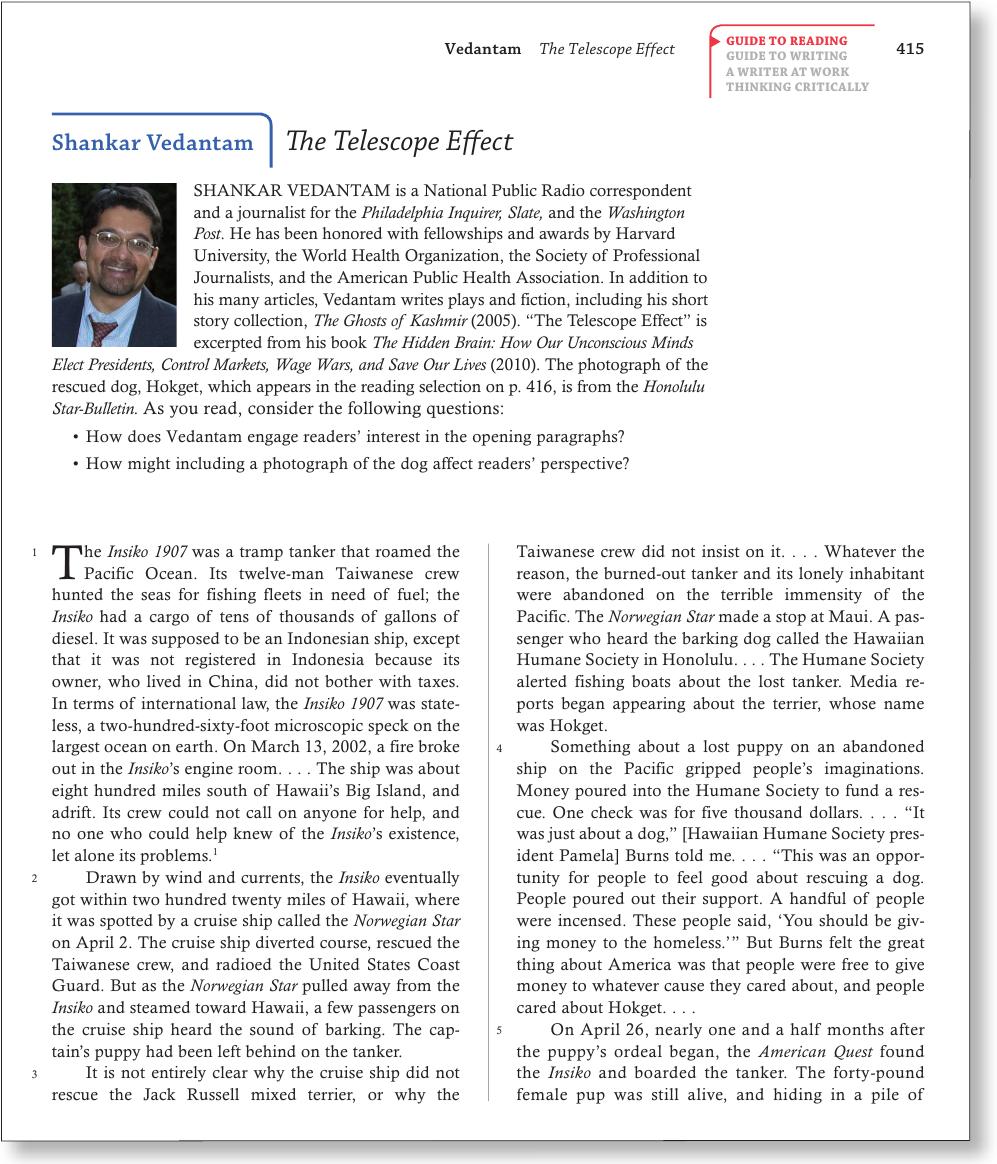
Active Learning
Leaner chapters make it easier for instructors to get and keep students reading and to focus their attention on what matters most. This edition of The St. Martin’s Guide to Writing is tighter and more focused than ever.
A new design helps guide students through the chapters, with headings that show students where they are, where they’ve been, and where they’re going in the chapter and that help students identify the activities and understand the purpose they serve in active learning.
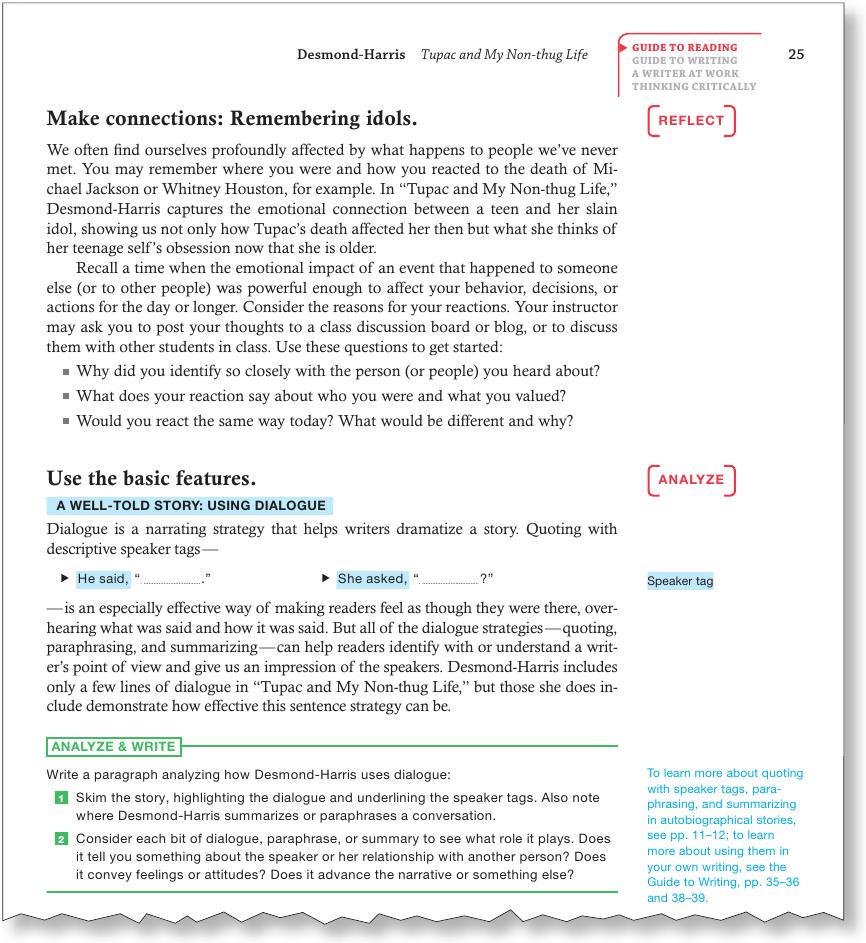
A mini table of contents and a Starting Points chart at the opening of each Guide to Writing section in Part One help students find the information they need. Starting Points, Critical Reading, and Troubleshooting guides use speech bubbles to prompt students to reflect on, interrogate, and revise their writing on their own.
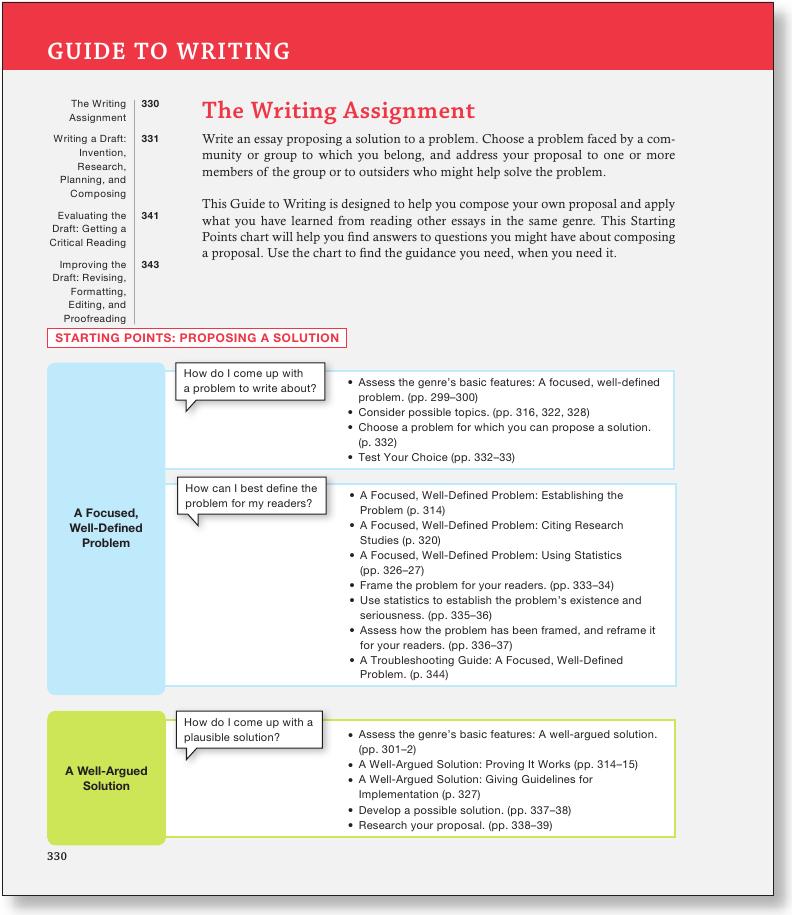
Color-coded highlighting and annotations show students the techniques writers use to communicate effectively with their readers.

Integrated sentence strategies foreground the sentence patterns writers use to communicate effectively with their readers. Examples from the reading selections demonstrate the flexibility of the pattern.
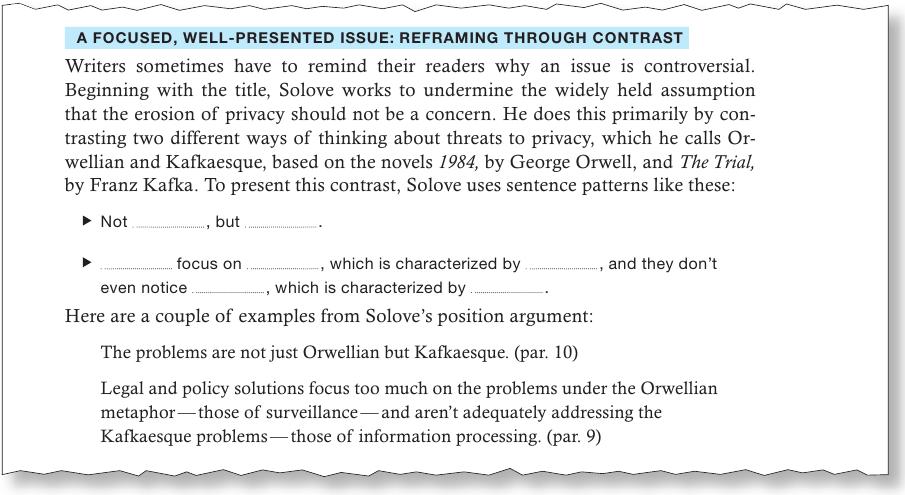
In the Guide to Writing, sentence strategies are integrated into the Ways In activities to invite students to use them for their own rhetorical purpose and to make them their own as they revise.
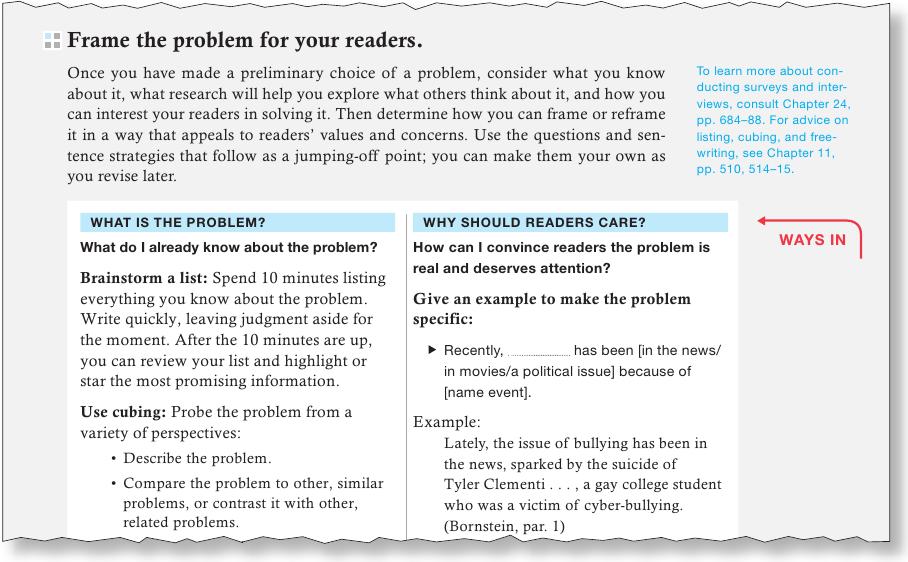
Greater attention to the writing situation helps students transfer the skills they’re learning to other courses and contexts: Practicing the Genre activities at the beginning of the chapter encourage students to explore the genre collaboratively. Playing with Genre boxes at the end of each Guide to Reading section encourage students to consider the effects of genre. A new chapter on writing in business and scientific genres encourages students to consider how genre drives design and formatting.
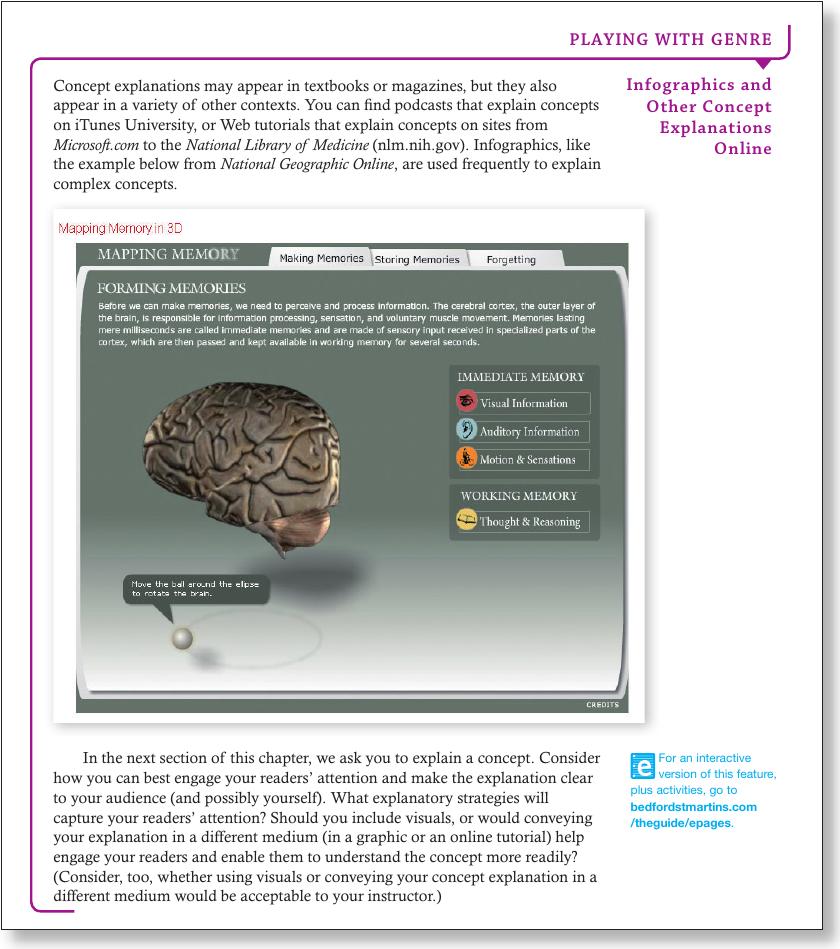
Council of Writing Program Administrators (WPA) Outcomes Statement
The St. Martin’s Guide to Writing, Tenth Edition, helps students build proficiency in the four categories of learning that writing programs across the country use to assess their students’ work: rhetorical knowledge; critical thinking, reading, and writing; writing processes; and knowledge of conventions. The chart below shows in detail how The St. Martin’s Guide helps students develop these proficiencies.
